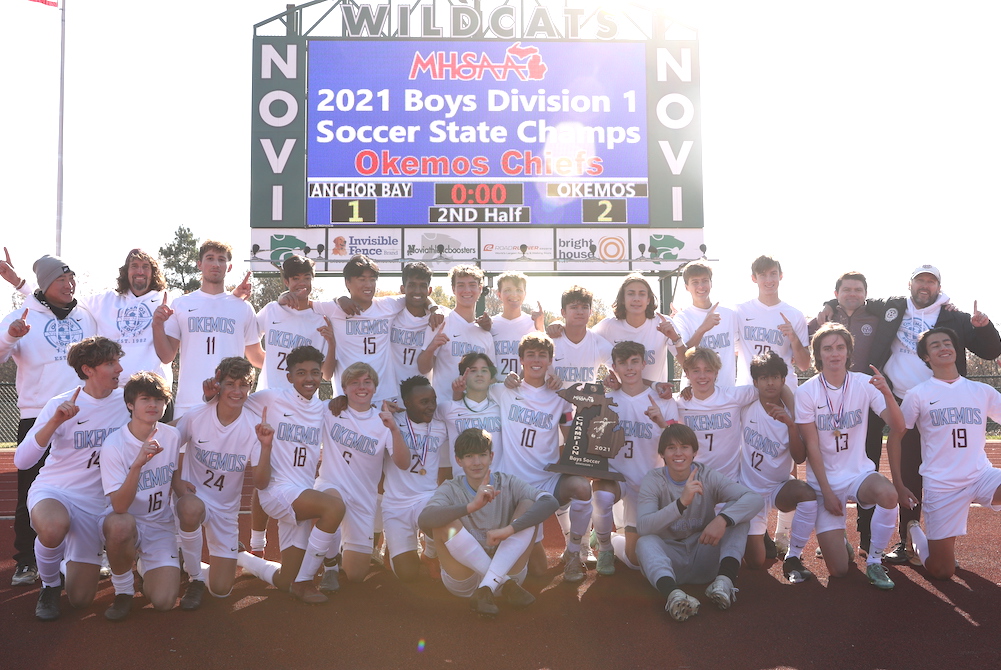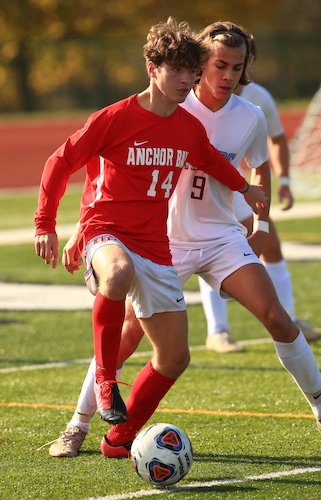
East Lansing Breaks Free for 4th Title
November 2, 2013
By Tom Kendra
Special to Second Half
KENTWOOD – Ben Swanson-Ralph was just looking to making something happen, to break the ice.
The senior forward did more than that – scoring what proved to be the game-winning goal late in the first half in East Lansing's 2-0 victory over Spring Lake on Saturday at Crestwood Middle School in the MHSAA Lower Peninsula Division 2 Boys Soccer championship game.
"Out of all the goals I've ever scored in soccer, this was the best," said Swanson-Ralph, an all-stater last year as a junior, who finished his senior season with 15 goals and 12 assists.
"I've always dreamed about playing in the state championship game and scoring a goal, but to actually have it happen, is indescribable. I'll remember it my whole life."
Swanson-Ralph picked up a loose ball about 25 yards in front of the goal, slid past a defender and then skidded a low shot into the right side of the net past Spring Lake keeper Joe Czajka. That tally broke a scoreless tie with 10:19 remaining in the first half.
The goal was critical because, up until that point, the game was progressing according to the plan of upset-minded Spring Lake.
While East Lansing was dominating possession and shots and generally keeping the ball in the Spring Lake end, the Trojans had been unable to break through. The defensive-oriented Lakers, like a boxer that allows his opponent to wear himself out, would have loved to go into halftime with a scoreless tie at cold and windy Pat Patterson Field.
Instead, Swanson-Ralph's goal gave his team the cushion and confidence it needed to open up its high-octane offensive attack, according to 38th-year coach Nick Archer.
East Lansing, which finished 25-2, won its fourth MHSAA boys soccer championship. The Trojans also won titles in 1987, 2002 and 2005, to go with two runner-up finishes.
 "I am so proud of these kids," said Archer, whose team outscored its seven postseason opponents by a combined score of 22-1, including a 3-0 victory over No. 2 Linden in the Regional Final. "There is so much pressure these days. I just want them to enjoy this moment."
"I am so proud of these kids," said Archer, whose team outscored its seven postseason opponents by a combined score of 22-1, including a 3-0 victory over No. 2 Linden in the Regional Final. "There is so much pressure these days. I just want them to enjoy this moment."
East Lansing, which finished with an 8-3 edge in shots on goal, came out on fire in the second half - with close-range chances by junior DeJuan Jones and sophomore Ian Carroll being stymied by Czajka, the Lakers' last line of defense.
The consistent EL pressure finally broke through again with 33:55 remaining in the game, when Spring Lake was over-aggressive on a corner kick.
The Trojans countered the Lakers' attack as Jones and Carroll broke into the open and then played a give-and-go game up the length of the artificial field in Kentwood. As they approached the goal, Carroll veered into the corner, drawing a defender, and then gave it back to Jones, who punched it into the back of the net. It was the 28th goal of the season for Jones, the Trojans' leading scorer.
"Ian and I hang out a lot and we know what the other one is thinking," said Jones. "We came out in the second half and tried to turn up the pressure and get another goal. It doesn't matter to us who scores; really, we just want to win."
The Lakers had a couple of scoring opportunities the rest of the way, notably from senior striker Nic Ellingboe and sophomore Keegan George. The East Lansing defensive corps of Grant Brogan, Michie Nimsombun, Torey Redmond, Andy Millar and goalkeeper Blair Moore were up to the challenge on each occasion to preserve the lead. Moore had to make just one save.
Spring Lake, which finished 16-7-3, played in its second MHSAA championship game in the past three years under 13th-year head coach Jeremy Thelen. The Lakers fell to Auburn Hills Avondale, 2-1, in the 2011 Final.
This year's Spring Lake team entered the tournament unranked with an underwhelming 10-6-3 record, but gained momentum when it stunned neighboring rival Fruitport, 2-1, in the District Semifinal. Fruitport had defeated Spring Lake twice in the regular season.
"Right now, it's hard for these kids to end with a loss," said Thelen. "But these kids will realize in time what a great season it was, especially since this tournament run was a bit unexpected."
PHOTOS: (Top) East Lansing goalkeeper Blair Moore steps in front of a shot as Spring Lake's Ryan Zietlow attempts to deflect. (Middle) East Lansing's DeJuan Jones (2) heads the ball during Saturday's game. (Click to see more from Hockey Weekly Action Photos.)

Okemos Finds Scoring Touch, Championship Stride in Comeback Win
By
Perry A. Farrell
Special for MHSAA.com
November 6, 2021
NOVI – For three quarters of the Division 1 championship match Saturday at Novi High School, undefeated Okemos’ offense was lifeless against New Baltimore Anchor Bay.
The Tars paid close attention to Jack Guggemos, and the Chiefs had no answers until suddenly, their preparation for a late-game, must-score scenario played out with a dream result.
Down by a goal, Okemos (20-0-4) scored two within two minutes, 17 seconds of each other during the final 10 minutes to claim its third Finals title in a physical 2-1 victory.
Ben Hussey scored off a great assist from Guggemos to tie the game at 1-1, and Aidan Antcliff scored the game-winner on a free kick from 20 yards out with seven minutes, 42 second to play.
“I just tried to get to the end line, and Ben was there,’’ said Guggemos. “He made a great run to the box and tapped it in. You have to deal with what’s thrown at you.
Guggemos had a lot to live up to. His coach and father, Brian, won a Class B title as a senior at Mason in 1989.
“No pressure, right,’’ Jack said, laughing. “It’s a great feeling being able to celebrate this with him.’’
Antcliff knew his shot was in once he booted it.
“It’s an unbelievable feeling,’’ said Antcliff, who scored just his second goal of the year. “It was a great shot. I practice that shot in the summertime. I got the opportunity in this game, and I made the most of it. Once I hit it, I knew it was going in.’’
 Anchor Bay (22-2-1) made its first appearance in Final, while Okemos won the 2004 Division 1 title and was the B-C champ in 1984.
Anchor Bay (22-2-1) made its first appearance in Final, while Okemos won the 2004 Division 1 title and was the B-C champ in 1984.
Okemos was led by all-state senior Guggemos, who set the school record with 45 goals this fall. Anchor Bay featured three past all-state players in Tanner Hodgson (first team), twin brother Carson Hodgson (second team) and goalie Evan Linsley (second team).
The Tars made sure Guggemos was surrounded any time he had the ball, sometimes with as many as three defenders.
“He was part of our game plan,’’ said Tars coach Nate Williams.
“It was a great game between two great soccer teams. We knew even up 1-0 we couldn’t take our foot off the gas.’’
Neither team generated offense in the first half, with most play at mid-field.
With 2:03 left in the first half, junior midfielder Francesco DiLorenzo blasted a shot past the Okemos keeper to give the upstart Tars a 1-0 lead heading into halftime.
Anchor Bay came out even more aggressive in the second half with the lead and a chance at the state title.
Guggemos was shackled, but he got free to send a pass near the net with 9:59 left that Hussey redirected into the net to tie the game at 1-1.
“It’s funny because my assistant coaches were talking about it,’’ said Okemos coach Brian Guggemos. “I’ve been doing it long enough to know you need to prepare for moments where you’re going to be down a goal. In the last three weeks we’ve practiced being down a goal. We’ve tried to make sure we were prepared for it. We said look, if we’re down a goal here’s the formation. We went into it right away, and then I told Ben and Owen (Brewer), our two forwards, get in there and crash the goal. That obviously turns the game around a little bit.
"Aidan hits a banger to win the state championship. We also practice those things everyday this time of the year. The guys have listened to the things we needed to do in practice. They paid attention, and that attention to detail has been pretty good for us."
PHOTO (Top) Okemos celebrates its first Finals championship since 2004 on Saturday. (Middle) Anchor Bay's Tanner Hodgson (14) works to control possession with Okemos' Ben Hussey defending. (Photos by Hockey Weekly Action Photos.)

